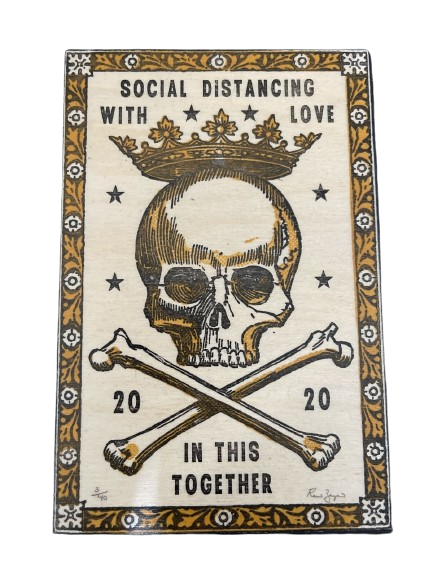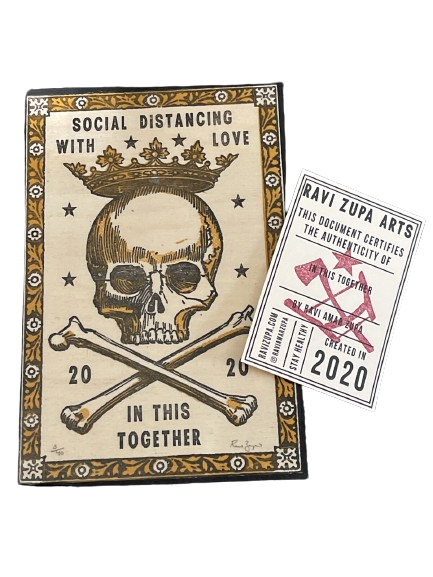
Virus


Ravi Amar Zupa In This Together Woodblock Print by Ravi Amar Zupa
In This Together Woodblock Print by Ravi Amar Zupa Hand-Pulled on Reclaimed Wood Panel Limited Edition Artwork. 2020 Signed & Numbered Limited Edition of 40 Artwork Size 4x5.75 Woodblock Print on Ready To Hang Slightly Distressed Wood Panel Depicting a Jolly Roger Skull and Cross Bones with Crown. Artwork Says: Social Distancing With Love 2020 In This Together. "In This Together" is a profound woodblock print by Ravi Amar Zupa, an artist known for his intricate hand-pulled prints on reclaimed wood panels. This limited edition artwork, part of a collection of only 40, reflects a moment defined by the global pandemic and encapsulates the ethos of solidarity and resilience. Measuring 4x5.75 inches, the piece is a compact yet powerful statement, ready to hang and slightly distressed, which adds to its raw appeal. The print features the iconic Jolly Roger skull and crossbones, crowned, a symbol historically associated with piracy but recontextualized here to signify unity in adversity. Symbolism and Technique in Zupa's Work Ravi Amar Zupa's choice of imagery and text in "In This Together" is evocative and timely. Paired with a crown, the skull and crossbones traditionally symbolize death and power. However, in the context of this artwork, they take on a new meaning, representing the collective struggle and the need to 'reign' over the crisis with compassion, as suggested by the phrase "Social Distancing With Love." The woodblock print technique, a traditional form of printmaking, lends a sense of timelessness and connects the work to a long history of artistic expression. At the same time, the reclaimed wood panel serves as a reminder of sustainability and resourcefulness. Cultural Resonance of the Artwork The cultural resonance of "In This Together" within the street pop art and graffiti artwork scene is significant. It captures a shared sentiment that transcended borders during the pandemic—solidarity. Zupa's work often explores themes of social and political significance, and this piece is no exception. It speaks to the heart of street art's social role: to comment, unite, and inspire. This artwork is not just a reflection of the times but also a rallying cry, a statement of support and empathy that resonated deeply during a time of global uncertainty. Collectability and Impact on Contemporary Art The collectability of "In This Together" lies in its limited edition status, signed and numbered by Zupa, which adds an element of exclusivity. The work's size makes it accessible, while its message and craftsmanship make it a significant addition to any collection of contemporary street pop art and graffiti artwork. The piece's impact is further enhanced by its medium—woodblock printing on wood panel—which bridges traditional art-making techniques with modern themes, thus appealing to a wide range of art enthusiasts and collectors. "In This Together" by Ravi Amar Zupa is a compelling piece of contemporary art that resonates with the communal spirit of street pop art and graffiti artwork. Through traditional woodblock printing on reclaimed wood, Zupa creates an artwork that is both a testament to the times and a timeless piece of artistry. It stands as a symbol of unity and love in a year marked by separation and uncertainty, offering a message of hope and togetherness that is as universal as it is powerful.
$240.00



